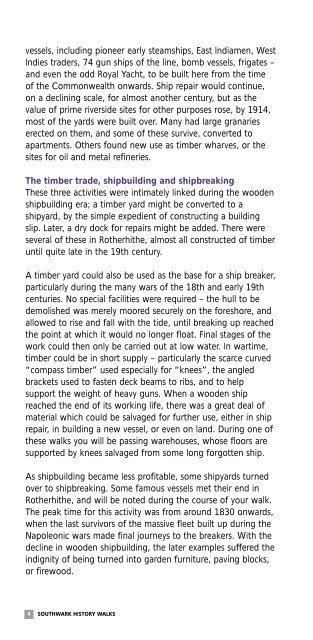Granaries, Shipyards and Wharves - Cycling from Guildford
Granaries, Shipyards and Wharves - Cycling from Guildford
Granaries, Shipyards and Wharves - Cycling from Guildford
You also want an ePaper? Increase the reach of your titles
YUMPU automatically turns print PDFs into web optimized ePapers that Google loves.
vessels, including pioneer early steamships, East Indiamen, West<br />
Indies traders, 74 gun ships of the line, bomb vessels, frigates –<br />
<strong>and</strong> even the odd Royal Yacht, to be built here <strong>from</strong> the time<br />
of the Commonwealth onwards. Ship repair would continue,<br />
on a declining scale, for almost another century, but as the<br />
value of prime riverside sites for other purposes rose, by 1914,<br />
most of the yards were built over. Many had large granaries<br />
erected on them, <strong>and</strong> some of these survive, converted to<br />
apartments. Others found new use as timber wharves, or the<br />
sites for oil <strong>and</strong> metal refineries.<br />
The timber trade, shipbuilding <strong>and</strong> shipbreaking<br />
These three activities were intimately linked during the wooden<br />
shipbuilding era; a timber yard might be converted to a<br />
shipyard, by the simple expedient of constructing a building<br />
slip. Later, a dry dock for repairs might be added. There were<br />
several of these in Rotherhithe, almost all constructed of timber<br />
until quite late in the 19th century.<br />
A timber yard could also be used as the base for a ship breaker,<br />
particularly during the many wars of the 18th <strong>and</strong> early 19th<br />
centuries. No special facilities were required – the hull to be<br />
demolished was merely moored securely on the foreshore, <strong>and</strong><br />
allowed to rise <strong>and</strong> fall with the tide, until breaking up reached<br />
the point at which it would no longer float. Final stages of the<br />
work could then only be carried out at low water. In wartime,<br />
timber could be in short supply – particularly the scarce curved<br />
“compass timber” used especially for “knees”, the angled<br />
brackets used to fasten deck beams to ribs, <strong>and</strong> to help<br />
support the weight of heavy guns. When a wooden ship<br />
reached the end of its working life, there was a great deal of<br />
material which could be salvaged for further use, either in ship<br />
repair, in building a new vessel, or even on l<strong>and</strong>. During one of<br />
these walks you will be passing warehouses, whose floors are<br />
supported by knees salvaged <strong>from</strong> some long forgotten ship.<br />
As shipbuilding became less profitable, some shipyards turned<br />
over to shipbreaking. Some famous vessels met their end in<br />
Rotherhithe, <strong>and</strong> will be noted during the course of your walk.<br />
The peak time for this activity was <strong>from</strong> around 1830 onwards,<br />
when the last survivors of the massive fleet built up during the<br />
Napoleonic wars made final journeys to the breakers. With the<br />
decline in wooden shipbuilding, the later examples suffered the<br />
indignity of being turned into garden furniture, paving blocks,<br />
or firewood.<br />
4 SOUTHWARK HISTORY WALKS


